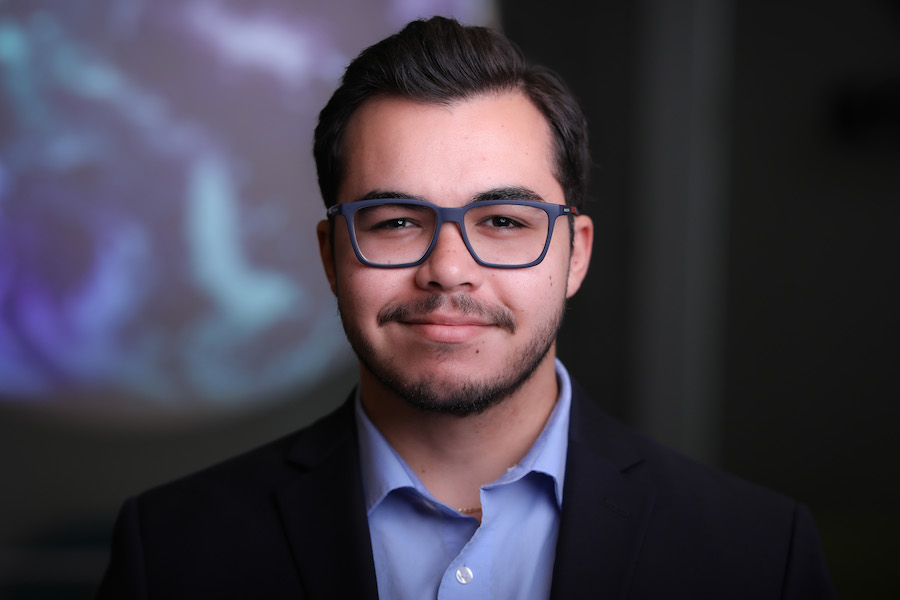Student Spotlight: Aaron Serre

Aaron Serre is a senior studying meteorology at Florida State University and plans to graduate in Spring 2024 from the Department of Earth, Ocean and Atmospheric Science, part of FSU’s College of Arts and Sciences. Serre’s passion for meteorology has led him to participate in several internships and volunteer opportunities with agencies such as NASA and the National Weather Service. Serre has also presented his research at multiple prestigious annual meetings, and helped produce FSU Weather, FSU’s student-run weather show.
Tell us a little about your background, where you’re from and what brought you to FSU.
I’m originally from California, but I attended high school in Tampa, Florida. Even in high school, I knew I wanted to pursue a degree in meteorology. After visiting FSU and learning about their amazing meteorology program, I knew I wanted to call FSU home for the next four years.
What inspired you to pursue a degree in meteorology?
Because I moved a lot and traveled throughout my life, I built a passion for wanting to study why weather changes. To me, understanding why one day it’s sunny outside and the next it’s cloudy has always been fascinating.
Tell us about working on the FSU Weather Show.
I’ve been involved with the FSU weather show for the past couple of years. When I first started, I was very nervous and didn’t want to do much broadcasting. I became more comfortable over the years, and this past year, I served as the team leader and producer for the Friday show. Holding these positions allowed me to learn how to better communicate and prioritize important details while working with others on the team.
Elaborate on your experience working for the National Weather Service as a volunteer student.
Starting in June 2022, I worked as a volunteer student with the National Weather Service in Tampa. In this position, I worked with operational meteorologists to support and learn office operations. I specifically helped with launching weather balloons, logging storm reports, and providing weather briefings to staff. I also had the opportunity to create my own forecasts for customers. This volunteer opportunity also allowed me to continue working for the National Weather Service as a Pathways Intern this past summer.
Tell us about your Pathways Internship experience at the National Weather Service.
I had the pleasure of working as a pathways intern at the National Weather Service office in Birmingham, Alabama. This internship was very similar to my experience as a volunteer student, but at the Birmingham office, I was given more opportunities to create forecasts and attend briefings. As an intern, I was able to go on a survey to investigate the results of predicted weather and the weather’s effects. Additionally, I utilized computer code to help automate different uses for data collected by weather equipment, allowing me to gain more experience with research.
Tell us about presenting research at both the 2019 National Weather Association annual meeting and the 2023 AMS annual meeting.
During my senior year of high school, I was involved with a social science research project that investigated how people perceive hurricane evacuations in media. I collaborated with different research partners to present our project at the 2019 National Weather Association annual meeting in Huntsville, Alabama. Attending this conference was a great networking opportunity, and I gained valuable experience presenting my research. This was a major foot in the door for me into the realm of meteorology research.
The second conference I attended was the 2023 American Meteorological Society annual meeting in Denver, Colorado. I worked with Chandler Pruett, a fellow FSU meteorology student who’s also majoring in statistics, to investigate the general public’s reactions to the National Hurricane Center’s cone of uncertainty, a graphic showing the projected path and intensity of a hurricane. By showing people simulations of different variations of the cone, we were able to measure people’s reactions and question if changes should be made to the cone to better communicate forecasts.
Why are your research topics important?
My research regarding hurricanes and the cone of uncertainty is important because it directly affects the public, a main audience within the field of meteorology. To get correct information out to the public, communication on the meteorologist’s end is essential. Spreading information to the public allows us to save lives and property, which are among meteorologists’ goals. This is achieved by aiming to get the best message out to the public and actively trying to create a stronger one every day.
Tell us about your work as a weather forecaster for NASA.
Volunteering as a weather forecaster for the NASA Blueflux project was an extremely rewarding experience. Our main task was to look at different weather components affecting the Everglades and use this information to advise pilots flying in to retrieve different chemical fluxes from the site.
What are some current goals you have?
Right now, my current goals are to graduate and continue improving upon what I’ve already built in the meteorology world by networking and gaining experience.
Even though leaving FSU may be bittersweet, what are you looking forward to once you graduate?
I look forward to being out in the field and meeting more likeminded individuals. One of the biggest motivators for me when pursuing meteorology was finding people with similar passions to myself. Even though we are a relatively small field, we have such large passions, so moving further into the field is something I’m truly looking forward to doing.

